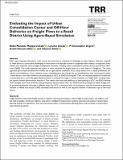| dc.contributor.author | Mepparambath, Rakhi Manohar | |
| dc.contributor.author | Cheah, Lynette | |
| dc.contributor.author | Zegras, P Christopher | |
| dc.contributor.author | Alho, André Romano | |
| dc.contributor.author | Sakai, Takanori | |
| dc.date.accessioned | 2024-08-27T19:18:22Z | |
| dc.date.available | 2024-08-27T19:18:22Z | |
| dc.date.issued | 2023-02 | |
| dc.identifier.uri | https://hdl.handle.net/1721.1/156402 | |
| dc.description.abstract | With rapid ongoing urbanization, cities across the world face a multitude of challenges in urban logistics. Delivery of goods to retail districts is particularly challenging as these places are typically located in congested urban centers. In response, policy makers have explored various freight management initiatives, including urban consolidation centers (UCC) and off-hour deliveries (OHD). This study examines the impact of these initiatives on freight flows to a retail district in Singapore. The study approach pairs empirical behavioral models and an agent-based simulation. First, using results from a stated preference survey, the choice behavior of two relevant actors—establishments that ship goods and establishments that receive goods within a retail district—and their likelihood of participating in UCC or OHD are analyzed. Then, the resulting behavioral models are incorporated into a city-scale agent-based simulator to evaluate the impact of these initiatives on freight flows, tracking multiple logistics-related performance indicators. The results show that the likelihood of participating in UCC and OHD declines when multiple actors are involved in the participation decision. Both UCC and OHD have the potential to reduce freight traffic and parking demand, although in different ways. For UCC, a minimum level of participation must be achieved to guarantee increase in vehicle load factors. OHD decreases load factors as well as the required number of dedicated trips to the retail district. | en_US |
| dc.language.iso | en | |
| dc.publisher | SAGE Publications | en_US |
| dc.relation.isversionof | 10.1177/03611981221092385 | en_US |
| dc.rights | Creative Commons Attribution-Noncommercial | en_US |
| dc.rights.uri | http://creativecommons.org/licenses/by-nc/4.0/ | en_US |
| dc.source | SAGE | en_US |
| dc.title | Evaluating the Impact of Urban Consolidation Center and Off-Hour Deliveries on Freight Flows to a Retail District Using Agent-Based Simulation | en_US |
| dc.type | Article | en_US |
| dc.identifier.citation | Mepparambath, R. M., Cheah, L., Zegras, P. C., Alho, A. R., & Sakai, T. (2023). Evaluating the Impact of Urban Consolidation Center and Off-Hour Deliveries on Freight Flows to a Retail District Using Agent-Based Simulation. Transportation Research Record, 2677(2), 264-281. | en_US |
| dc.contributor.department | Singapore-MIT Alliance in Research and Technology (SMART) | |
| dc.contributor.department | Massachusetts Institute of Technology. Department of Urban Studies and Planning | |
| dc.relation.journal | Transportation Research Record: Journal of the Transportation Research Board | en_US |
| dc.eprint.version | Final published version | en_US |
| dc.type.uri | http://purl.org/eprint/type/JournalArticle | en_US |
| eprint.status | http://purl.org/eprint/status/PeerReviewed | en_US |
| dc.date.updated | 2024-08-27T19:09:22Z | |
| dspace.orderedauthors | Mepparambath, RM; Cheah, L; Zegras, PC; Alho, AR; Sakai, T | en_US |
| dspace.date.submission | 2024-08-27T19:09:24Z | |
| mit.journal.volume | 2677 | en_US |
| mit.journal.issue | 2 | en_US |
| mit.license | PUBLISHER_CC | |
| mit.metadata.status | Authority Work and Publication Information Needed | en_US |
